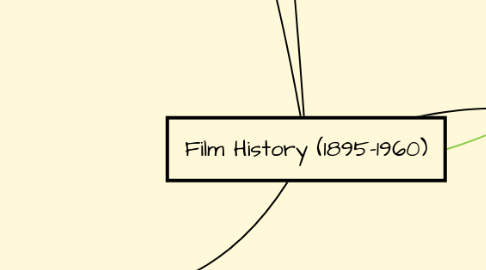
1. Hollywood as an Industry (1920-1930)
1.1. Three main components
1.1.1. Production
1.1.2. Distribution
1.1.3. Presentation
1.2. Hollywood started after the WWI when the United States realized that cinema was a great "money fabric" and started producing films in Hollywood, California, thanks to its weather
1.2.1. The introduction of sound in movies
1.3. Nickelodeons
1.3.1. These where small theaters where movies where screened on. It gained massive popularity thanks to its price (A nickel) and it was mainly attended by the low class of society.
1.4. Major movie studios "Big five"
1.4.1. Paramount
1.4.2. Loew´s
1.4.3. Fox Film
1.4.4. Warner Brothers
1.4.5. RKO studios
1.5. Minor movie studios
1.5.1. Columbia
1.5.2. Universal Studios
1.5.3. UA (United Artists) studios
1.6. Golden Age 1930s
1.6.1. Film noir
1.6.1.1. Black and white movies which featured several different types of genders. (Violence, Anti-hero as the main character, femme fatale , etc)
1.6.1.1.1. Scarface (1932) The main character was an outlaw which was inspired by Al Capone and the crimes he committed. The first movie to introduce heavy violence on screen.
1.6.2. Epic Films
1.6.2.1. Films that introduced epic stories to the theaters for the first time
1.6.2.1.1. Tarzan "The Ape Man"
1.6.2.1.2. King Kong
1.6.2.1.3. The adventures of Robin Hood
1.6.3. Horror Films
1.6.3.1. In this era horror times where in their golden age thanks to different movie studios (Mainly Universal Studios) which introduced monsters as main characters.
1.6.3.1.1. Dracula
1.6.3.1.2. Frankenstein
1.6.3.1.3. The mummy
1.6.3.1.4. Freaks
2. 1940s
2.1. Thanks to WWII hollywood expanded and started to be a global phenomena. It introduced realistic movies with realistic settings and was represented the whole idealism of America as a nation and its ideals
2.1.1. Casa Blanca
2.1.2. The Great Dictator
2.1.2.1. One of Chaplin´s biggest movies. He portrayed a dictator that made allusion to Hitler´s ideals. But Chaplin tried to make fun of this ideals and tried to send a message of how Fascism was some kind of cancer for society and it needed to be destroyed. The movie premier was in France shortly after Hitler´s occupation of the country as a sing of direct protest against him and all he represented.
2.1.3. Foreign influences
2.1.3.1. Alfred Hitchcock
2.1.3.1.1. Consideres as the master of suspense. Introduced very different techniques into the film industry. Also considered as the best director of England.
2.1.3.1.2. Psycho (1960)
2.1.3.1.3. Vertigo (1958)
3. (1950s 1960s)
3.1. The "theater golden era" was destroyed thanks to the introduction of free television, while audiences preferred to watch a movie from their living rooms. The creation of auto-cinemas and the introduction to color into television completely changed the hollywood industry for ever.
4. Silent Film Period
4.1. The Lumieré Brothers invented the Cinematographe in 1895.
4.1.1. The first movie ever made was directed by them and it was called "Workers leaving the factory". They also directed another movie called "Arrival of a train" which is considered to be the first horror movie.
4.2. Georges Méliès
4.2.1. He directed "A trip to the moon" in 1902; which is considered to be the first sci.fi movie ever made. This movie also predicted that humans would be doing trips to the outer space in the future.
4.3. Edwin S. Porter
4.3.1. He directed a movie called "The Great Train Robbery" in 1903. This was the first movie that included "scenes" and the first movie to have another thing happening in the same scene (The arrival of a train to the station).
4.4. D.W. Griffith
4.4.1. In 1915 he produced and directed "The birth of a nation" originally named "The clansman". This movie is considered to be the greatest movie ever made thanks to all the are techniques it introduced, like the fist scene filmed by night. Despite all of the promotion and glorification of racism against black people. The KKK is represented as the saviors of a village, while black people are portrayed as wild animals who act by instinct and only want to destroy society.
4.5. Charles Chaplin
4.5.1. Better known as "Charlie Chaplin" is considered as the greatest comedian of all times. In 1936 he directed, produced and acted as the main character of his movie called "Modern Times", in which he portrayed his character "The Tramp" and was basically a protest against all the chaos that was originated thanks to the great depression (1929) and also acted as a voice for the poor people in those times.
